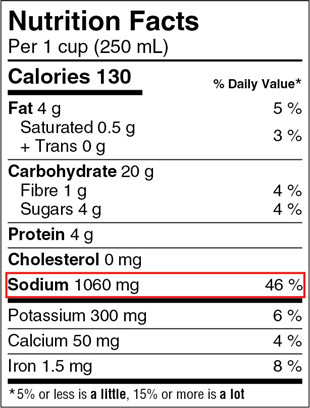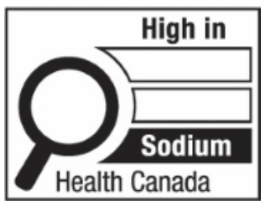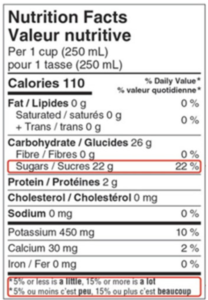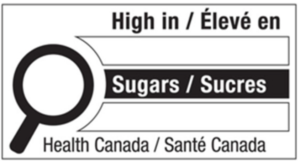Canned vegetables and fruit can have added sodium (salt) and sugars added for flavour, colour, and to help preserve them. Learn how to read labels and nutrient content claims for sodium and sugars below!
Spot the Salt
You can find how much sodium (salt) is added to food products by reading nutrition labels and product claims. Fun Fact: Foods like fresh fruits and vegetables do not have nutrition facts listed on the food and usually contain little to no sodium.
Start with Serving Sizes: Read the serving size on the Nutrition Facts Label. The serving size is the amount of the food product that the nutrition information is based on. You can use this information along with the total weight of the food package to determine how many servings are in the package.
Check the Percent Daily Value (% DV): The Percent Daily Value tells you if a food has a little (≤5% DV) or a lot (≥15% DV) of a nutrient. The percentage of each nutrient in a single serving is based on the daily recommended amount.
Let’s look at an example using the photo below! Here, just 1 cup of the product (1 serving) has 46% DV provides almost half of the recommended daily limit for sodium intake, based on a 2000 calorie diet! For nutrients, 5% DV or less is a little, and 15% DV or more is a lot, so choose foods with a lower % DV for sodium (5% DV or less) most often.

Photo from Health Canada https://www.canada.ca/content/dam/hc-sc/images/services/nutrients/sodium/using-food-labels/sodium-en.jpg
Look for any ingredient with sodium in the name (e.g., sodium chloride): Check for hidden sources of sodium – these could be listed as salt, sodium, soy sauce, kosher salt, smoked salt, fleur de sel, sea salt, meat tenderizer, yeast extract, salted herbs, or spices. Ingredients are listed in descending order by weight, meaning the closer to the beginning of the ingredient list they are, the higher the amount is in the product. Prioritize products with no sodium in the list or make sure salt is listed closer to the end of the ingredients list.
LABEL ALERT! Check the Product Statement and Nutrient Content Claims: You may have seen claims like “Low Sodium”, “No Added Salt”, and “Sodium Reduced” on products, but what do they mean? See some examples below!
- Free of Sodium or Salt: A serving has under 5 mg of sodium. Claim examples: “No Sodium” or “Salt-Free”
- Low in Sodium or Salt: A serving has 140 mg or less of sodium. Claim examples: “Low Sodium” or “Low Salt” (≤5%DV sodium on the Nutrition Facts table)
- Reduced or Lower in Sodium or Salt: Beware, these foods can still be high in sodium! Front of pack claim examples: “Reduced Sodium”, “Lower in Salt” or “Less Salt” means that 1 serving (see Nutrition Facts table for serving size details) must have at least 25% less sodium than the original product or food.
- No Added Sodium or Salt: A serving of the food has no added salt or sodium salts (check the ingredient list to confirm) but there may be sodium in the food naturally (e.g. milk, celery). Claim examples: “Unsalted” or “Without Added Salt”
- Lightly Salted: A serving has 50% less salt than what is normally added. Claim examples: “Lightly Salted” or “Salted Lightly”
Use the Front of Pack Label: “High in Sodium” on the front of pack label will be on those products that have 15% or more of the Daily Value for salt. These labels will be mandatory by January 1st of 2026, so keep your eyes peeled!

Photo from Health Canada https://www.canada.ca/en/health-canada/services/food-nutrition/legislation-guidelines/guidance-documents/front-package-nutrition-symbol-labelling-industry.html
Finding Sugars in Products
Start with Serving Sizes: Read the serving size on the Nutrition Facts Label. The serving size is the amount of the food product that the nutrition information is based on. You can use this information along with the total weight of the food package to determine how many servings are in the package.
Scan the Nutrition Facts Table: o compare sugar contents and make healthier choices. The Percent Daily Value tells you if a food has a little (≤ 5% DV) or a lot (≥15% DV) of a nutrient. The percentage of each nutrient in a single serving is based on the daily recommended amount.
Let’s look at an example using the photo below! Here, 1 cup of the product (1 serving) has 22% DV. For nutrients, 5% DV or less is a little, and 15% DV or more is a lot, so choose foods with a lower %DV for sodium (5% DV or less) most often.

Photo from Health Canada https://www.canada.ca/en/health-canada/services/nutrients/sugars/using-food-labels.html
Ingredients List: Identify sugars by their various names, such as high-fructose corn syrup, honey, and concentrated fruit juice. Sugar-based ingredients are found in brackets after the word sugars and are listed in descending order based on weight. In the photo, you can see that sugars are the first ingredient and make up most of the product, with fancy molasses being in the largest amount.

Photo from Health Canada https://www.canada.ca/en/health-canada/services/nutrients/sugars/using-food-labels.html
LABEL ALERT! Check the Product Statement and Claims: You may have seen claims like “Low Sugar”, “No Added Sugar”, and “Reduced Sugar” on products, but what do they mean? See some examples below!
- Free of Sugars: A serving has under 0.5 grams of sugars. Claim examples: “Sugar-Free” or “Zero Sugar”
- Low in Sugars: A serving has 5 grams (g) of sugars or less. Claim examples: “Low Sugar” or “Little Sugar”
- Reduced or Lower in Sugars: Beware, these foods can still be high in sugars! A serving has at least 25% less sugar than the regular product or food. Claim examples: “Reduced Sugar”, “Lower in Sugar” or “Less Sugar”.
- No Added Sugars: A serving has no sugar or sugar-containing ingredients added. There may still be sugars in the food naturally. Claim examples: “No Sugar Added” or “Without Added Salt”
Front of Pack Label: Look for the words “High in Sugars” on the front of pack label. This will show on packages when products have 15% or more of the Daily Value for sugars. Products will slowly be adding these labels until it is mandatory on January 1st of 2026, so keep your eyes peeled!

Photo from Health Canada https://www.canada.ca/en/health-canada/services/nutrients/sugars/using-food-labels.html
